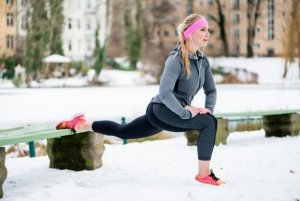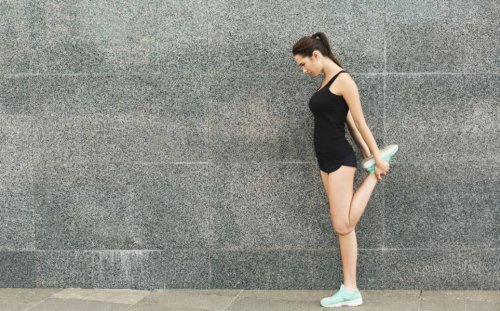Tips for Training in the Winter and Avoiding Injury

Winter brings a change in temperature. As an athlete, you must be alert to weather changes because it could cause you to suffer some type of injury. Therefore in this article, we’ll give you some tips for training in winter time and avoiding injuries. Take notes and try to keep them in mind!
Truly, many athletes start training with enthusiasm but end up quitting after a physical injury. However, the good news is that these injuries can be prevented easily with the proper precautions and the right mentality.
Likewise, some of the most popular winter activities, such as snowboarding, skating or skiing are done in harsh weather conditions. This hostile environment is related to an increase in injuries. If you’re going to participate in these activities be sure to use the proper safety gear.
The best tips to train in winter and avoid injury
Here are some suggestions on how to keep your body working without suffering any injuries during your winter workouts:
1. A good warmup for winter training to avoid injury
The first tip we’ll give you is to warm up properly. It’s true this stands all year round, but it becomes crucial when temperatures are low. Of course, it’s never a good idea to train when your muscles are cold.
In this sense, you must make sure you are warming up your body properly. This with the objective of increasing body temperature and blood flow to help the muscles work.

Likewise, you must also prepare yourself mentally for the task at hand. If you skip warming up, you’ll take the risk of suffering from injuries that require time and rest to heal.
Therefore, dedicate only 10 minutes to light cardio routines, such as jumping jacks, jogging or an elliptical trainer to prepare your body for activity.
2. Stretching
An essential part of warming up is, without doubt, stretching. Stretching your muscles before working them out increases flexibility. Among other things, this increase will improve your performance while training, besides reducing the risk of injuries.
In fact, you must also stretch all the muscles you worked out during your session once you’re finished. Stretching before and after is the only way to avoid the risk of injuries.
3. Eat moderately for winter training and avoiding injury
What you eat and drink is as important as your training. In this sense, carbohydrates will not only give you energy for your winter training and help avoid injury, but they’ll also replenish your glycogen reserves for your recovery. This way you’ll be ready for your next winter training and workout.
On the other hand, proteins after winter training are also as important. They’ll help you repair the muscles you’ve just used.
If you consider it suitable, you may seek help from a sports nutritionist to understand when, how and which food you must eat in order to stay healthy and maintain energy for your training.
Providing your body with the necessary protein after working out to repair muscle fiber, is of course, as important as consuming carbohydrates before training to have energy.
4. Listen to your body
Knowing how to interpret the signs your body sends is one of the best ways to avoid any type of injury during winter. In fact, your body will send you signs of when you need to slow down and when you need to stop completely. If you feel pain in your knees, then it’s time to adjust your workout routine.

In many cases, rest and recovery may be the only things your body is looking for. Therefore, you need to make sure that you take the necessary days off. Your body will be earning real profits during this time.
Before we end, we remind you, as with any other season of the year, injuries appear when we least expect them. In this sense, it’s essential that you put the previous advice into practice to minimize the chances of suffering an injury. Prevention in these cases is the best option.
Winter brings a change in temperature. As an athlete, you must be alert to weather changes because it could cause you to suffer some type of injury. Therefore in this article, we’ll give you some tips for training in winter time and avoiding injuries. Take notes and try to keep them in mind!
Truly, many athletes start training with enthusiasm but end up quitting after a physical injury. However, the good news is that these injuries can be prevented easily with the proper precautions and the right mentality.
Likewise, some of the most popular winter activities, such as snowboarding, skating or skiing are done in harsh weather conditions. This hostile environment is related to an increase in injuries. If you’re going to participate in these activities be sure to use the proper safety gear.
The best tips to train in winter and avoid injury
Here are some suggestions on how to keep your body working without suffering any injuries during your winter workouts:
1. A good warmup for winter training to avoid injury
The first tip we’ll give you is to warm up properly. It’s true this stands all year round, but it becomes crucial when temperatures are low. Of course, it’s never a good idea to train when your muscles are cold.
In this sense, you must make sure you are warming up your body properly. This with the objective of increasing body temperature and blood flow to help the muscles work.

Likewise, you must also prepare yourself mentally for the task at hand. If you skip warming up, you’ll take the risk of suffering from injuries that require time and rest to heal.
Therefore, dedicate only 10 minutes to light cardio routines, such as jumping jacks, jogging or an elliptical trainer to prepare your body for activity.
2. Stretching
An essential part of warming up is, without doubt, stretching. Stretching your muscles before working them out increases flexibility. Among other things, this increase will improve your performance while training, besides reducing the risk of injuries.
In fact, you must also stretch all the muscles you worked out during your session once you’re finished. Stretching before and after is the only way to avoid the risk of injuries.
3. Eat moderately for winter training and avoiding injury
What you eat and drink is as important as your training. In this sense, carbohydrates will not only give you energy for your winter training and help avoid injury, but they’ll also replenish your glycogen reserves for your recovery. This way you’ll be ready for your next winter training and workout.
On the other hand, proteins after winter training are also as important. They’ll help you repair the muscles you’ve just used.
If you consider it suitable, you may seek help from a sports nutritionist to understand when, how and which food you must eat in order to stay healthy and maintain energy for your training.
Providing your body with the necessary protein after working out to repair muscle fiber, is of course, as important as consuming carbohydrates before training to have energy.
4. Listen to your body
Knowing how to interpret the signs your body sends is one of the best ways to avoid any type of injury during winter. In fact, your body will send you signs of when you need to slow down and when you need to stop completely. If you feel pain in your knees, then it’s time to adjust your workout routine.

In many cases, rest and recovery may be the only things your body is looking for. Therefore, you need to make sure that you take the necessary days off. Your body will be earning real profits during this time.
Before we end, we remind you, as with any other season of the year, injuries appear when we least expect them. In this sense, it’s essential that you put the previous advice into practice to minimize the chances of suffering an injury. Prevention in these cases is the best option.
All cited sources were thoroughly reviewed by our team to ensure their quality, reliability, currency, and validity. The bibliography of this article was considered reliable and of academic or scientific accuracy.
- Chaze, B., & McDonald, P. (2009, February). Head Injuries in Winter Sports: Downhill Skiing, Snowboarding, Sledding, Snowmobiling, Ice Skating and Ice Hockey. Physical Medicine and Rehabilitation Clinics of North America. https://doi.org/10.1016/j.pmr.2008.10.016
- Orchard, J. (2002). Is there a relationship between ground and climatic conditions and injuries in football? Sports Medicine. https://doi.org/10.2165/00007256-200232070-00002
This text is provided for informational purposes only and does not replace consultation with a professional. If in doubt, consult your specialist.








